Articles
- Page Path
- HOME > Korean J Community Nutr > Volume 16(6); 2011 > Article
-
Original Article
- Development and Effects' Analysis of Nutrition Education Pamphlet for the Lower Grades Elementary Students -Focused on Individual Daily Needed Food Exchange Units-
- Min-Jung Son, Young-Sook Cho, Se-Na Kim, Hye-Ji Seo, Sook-Bae Kim
-
Korean Journal of Community Nutrition 2011;16(6):647-660.
DOI: https://doi.org/10.5720/kjcn.2011.16.6.647
Published online: December 31, 2011
Graduate School of Education, Chonbuk National University, Jeonju, Korea.
1Department of Agrofood Resources, NAAS, RDA, Suwon, Korea.
2Department of Food Science & Human Nutrition, Research Institute of Human Ecology, Chonbuk National University, Jeonju, Korea.
- Corresponding author: Sook-Bae Kim, Chonbuk National University, 664-14, Duk-Jin Dong 1-Ga, Duk-Jin Gu, Jeonju 561-756, Korea. Tel: (063) 270-3823, Fax: (063) 270-3854, sbkim@jbnu.ac.kr
Copyright © 2011 The Korean Society of Community Nutrition
- 1,049 Views
- 0 Download
- 4 Crossref
Figure & Data
REFERENCES
Citations

- Effects of Nutrition Education Using Dietary Guidebook in Higher Grade Elementary Students of Jeonbuk Area
Mi-Ran Park, Sook-Bae Kim
Korean Journal of Community Nutrition.2018; 23(1): 13. CrossRef - Effects of Nutrition Education Providing School Lunch by Personalized Daily Needed Food Exchange Units for Adolescent Athletes in Jeonbuk Province
Kang-Mo Ko, Sook-Bae Kim
Korean Journal of Community Nutrition.2016; 21(1): 25. CrossRef - Effects of Nutrition Education for Chinese College Students in Korea - Focused on Personalized Daily Energy Requirement and Food Exchange Units -
Jia-Li Guo, Soon-Kyung Kim, Jeong-Weon Kim, Mi-Hyun Kim, Se-Na Kim, Sook-Bae Kim
Korean Journal of Community Nutrition.2013; 18(6): 565. CrossRef - Development and Effects' Analysis of Nutrition Education Pamphlet for the Higherr Grades Elementary Students -Focused on Individual Daily Needed Food Exchange Units-
Eun-Su Lim, Young-Sook Cho, Se-Na Kim, Sook-Bae Kim
Korean Journal of Community Nutrition.2012; 17(6): 689. CrossRef
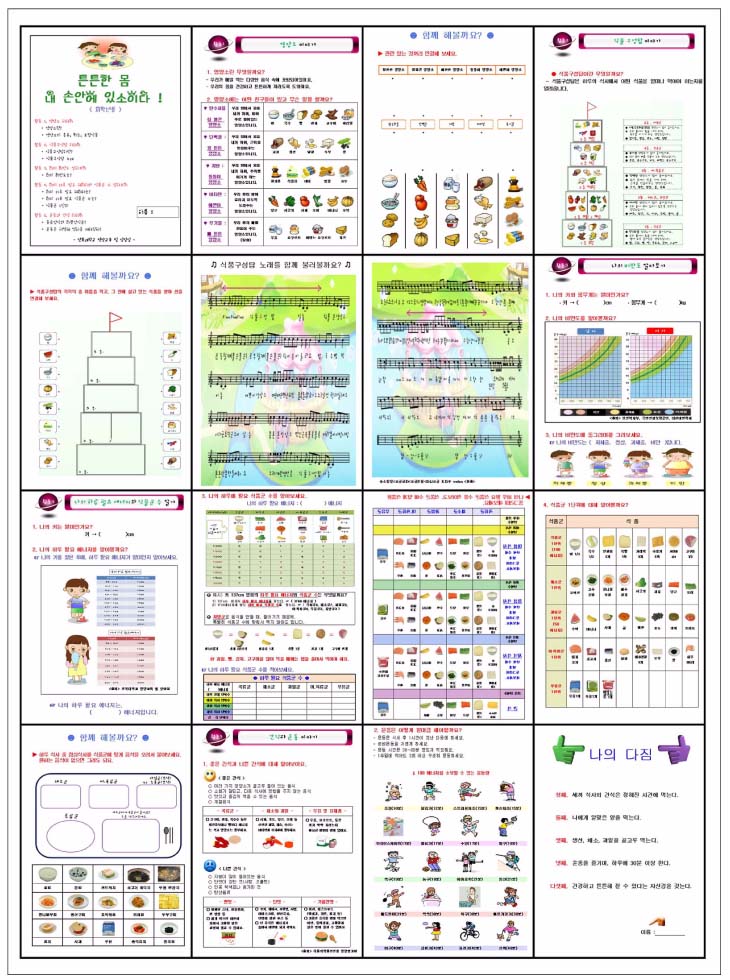
Fig. 1
Contents and tools of nutrition education program
Height, weight, obesity index of the subjects
1) Mean ± SD
2) Obesity index (%) = (Real weight - Standard weight) / Standard weight × 100
< -10% : underweight, -10% ≤ < 10% : normal, 10% ≤ < 20% : overweight, 20% ≤ : obese
3) N (%)
NS : Not Significant
Effects on nutrition knowledge of the subjects
1) Mean ± SD
2) by t-test
3) by ANCOVA test
*: p < 0.05, **: p < 0.01, ***: p < 0.001
NS: Not Significant
Score: non-corrected, 0; corrected, 1
Effects on dietary attitudes of the subjects
1) Mean ± SD
**: p < 0.01 by t-test
(R) denotes a negatively phrased and reversely scored item
NS: Not Significant
Score: seldom, 1; often, 2; frequent, 3; always, 4
Effects on type and frequency of meal and snack
1) N (%)
*: p < 0.05, **: p < 0.01 by chi-square test
NS: Not Significant
Effects on nutrients intake of the subjects
1) Mean ± SD
2) by t-test
3) by ANCOVA test
*: p < 0.05, **: p < 0.01, ***: p < 0.001
NS: Not Significant
Effects on energy, protein and fiber intake of the subjects
1) N (%)
EER: Estimated Energy Requirement
EAR: Estimated Average Requirement
RNI: Recommended Nutrient Intake
AI: Adequate Intake
NS: Not Significant by Mann-Whitney U Test
Effects on vitamins intake of the subjects
1) N (%), *: p < 0.05, **: p < 0.01, ***: p < 0.001 by Mann-Whitney U Test
EAR: Estimated Average Requirement, RNI: Recommended Nutrient Intake, UL: Tolerable Upper Intake Level, AI: Adequate Intake, NS: Not Significant
Effects on Minerals intake of the subjects
1) N (%), ***: p < 0.001, *: p < 0.05 by Mann-Whitney U Test
EAR: Estimated Average Requirement, RNI: Recommended Nutrient Intake, UL: Tolerable Upper Intake Level, AI: Adequate Intake, Goal: Population nutrient intake goal, NS: Not Significant
Satisfaction with developed program and pamphlet of the subjects
1) N (%)
2) Mean ± SD
Score: Dissatisfied 1, Normal 2, Satisfied 3
1) Mean ± SD 2) Obesity index (%) = (Real weight - Standard weight) / Standard weight × 100 < -10% : underweight, -10% ≤ < 10% : normal, 10% ≤ < 20% : overweight, 20% ≤ : obese 3) N (%) NS : Not Significant
1) Mean ± SD 2) by 3) by ANCOVA test *: NS: Not Significant Score: non-corrected, 0; corrected, 1
1) Mean ± SD **: (R) denotes a negatively phrased and reversely scored item NS: Not Significant Score: seldom, 1; often, 2; frequent, 3; always, 4
1) N (%) *: NS: Not Significant
1) Mean ± SD 2) by 3) by ANCOVA test *: NS: Not Significant
1) N (%) EER: Estimated Energy Requirement EAR: Estimated Average Requirement RNI: Recommended Nutrient Intake AI: Adequate Intake NS: Not Significant by Mann-Whitney U Test
1) N (%), *: EAR: Estimated Average Requirement, RNI: Recommended Nutrient Intake, UL: Tolerable Upper Intake Level, AI: Adequate Intake, NS: Not Significant
1) N (%), ***: EAR: Estimated Average Requirement, RNI: Recommended Nutrient Intake, UL: Tolerable Upper Intake Level, AI: Adequate Intake, Goal: Population nutrient intake goal, NS: Not Significant
1) N (%) 2) Mean ± SD Score: Dissatisfied 1, Normal 2, Satisfied 3

 KSCN
KSCN



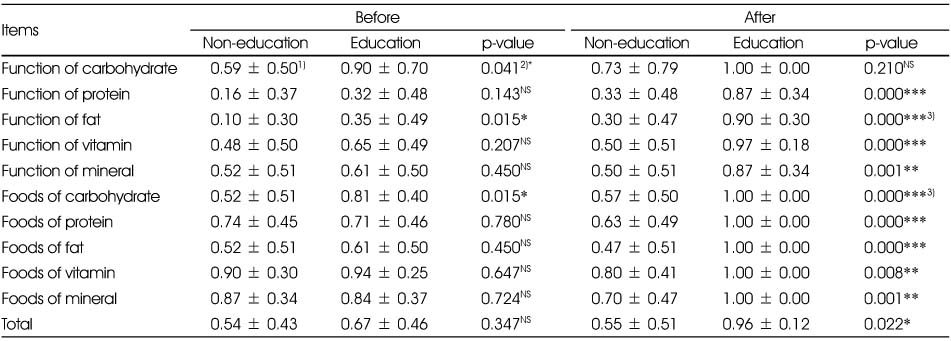

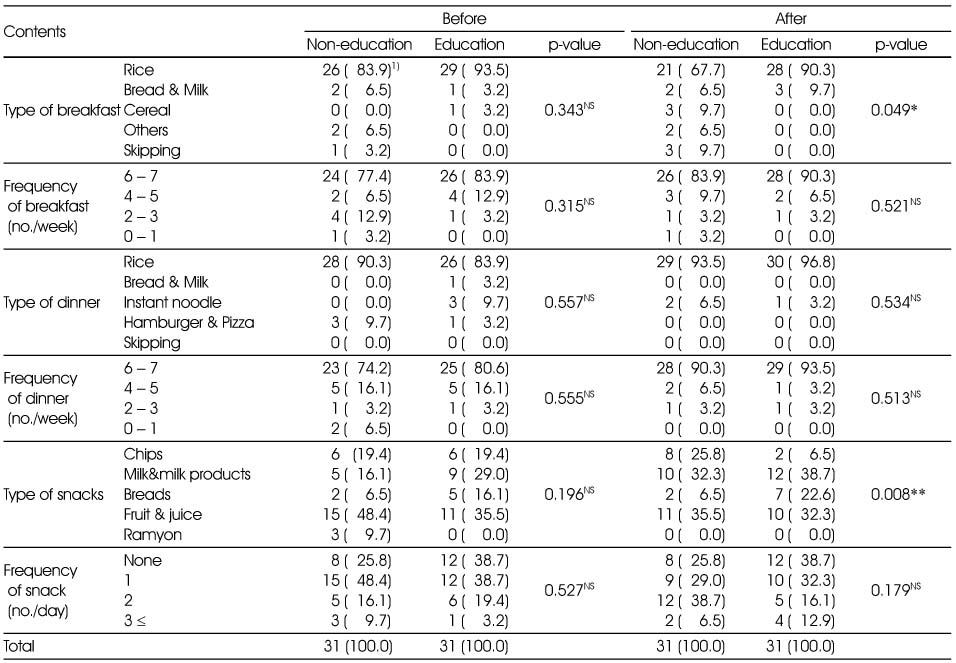
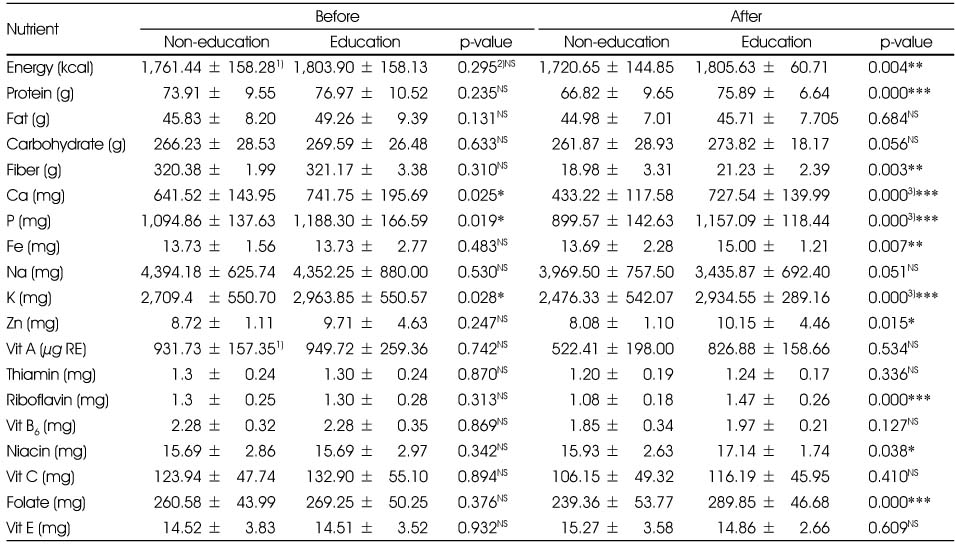

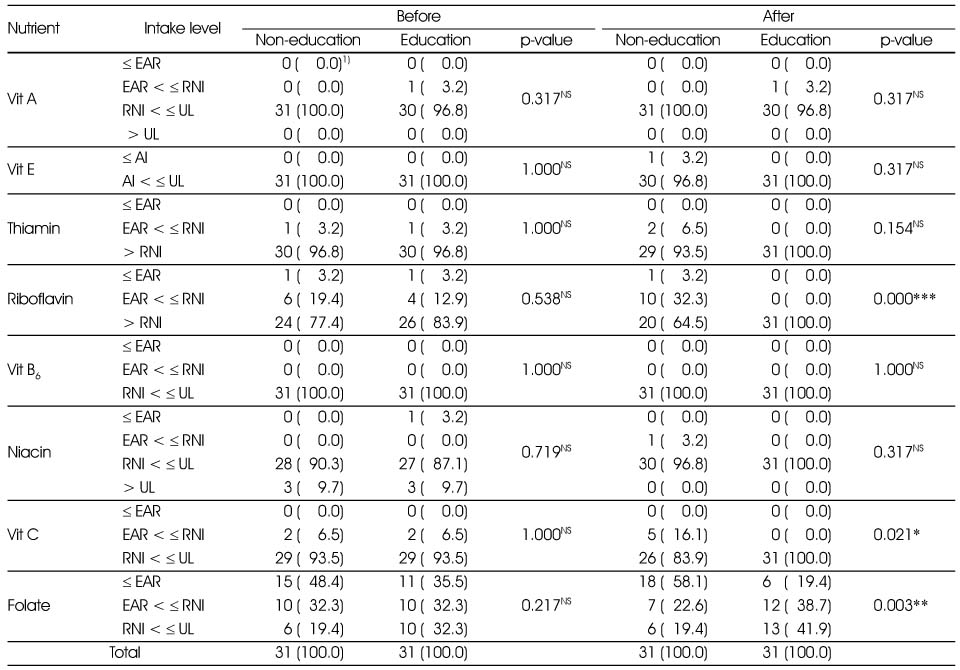
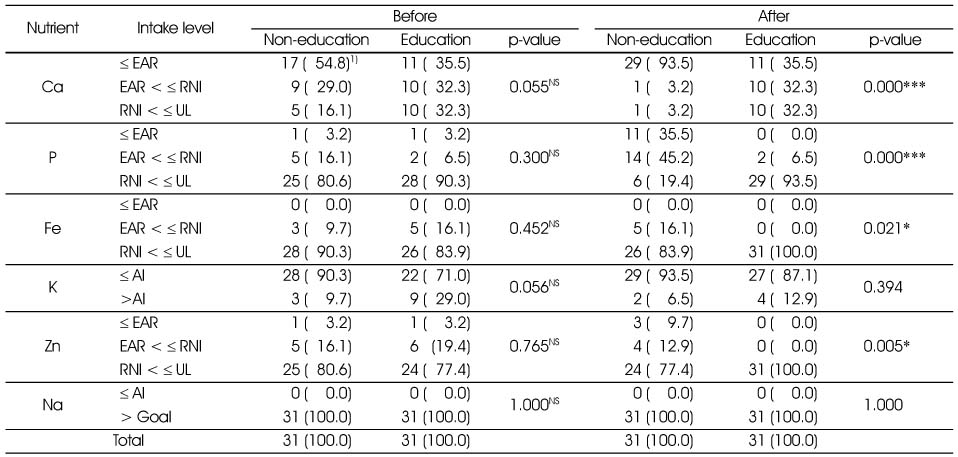
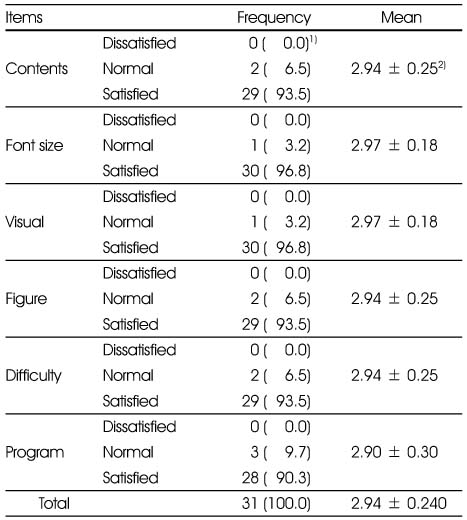
 Cite
Cite


